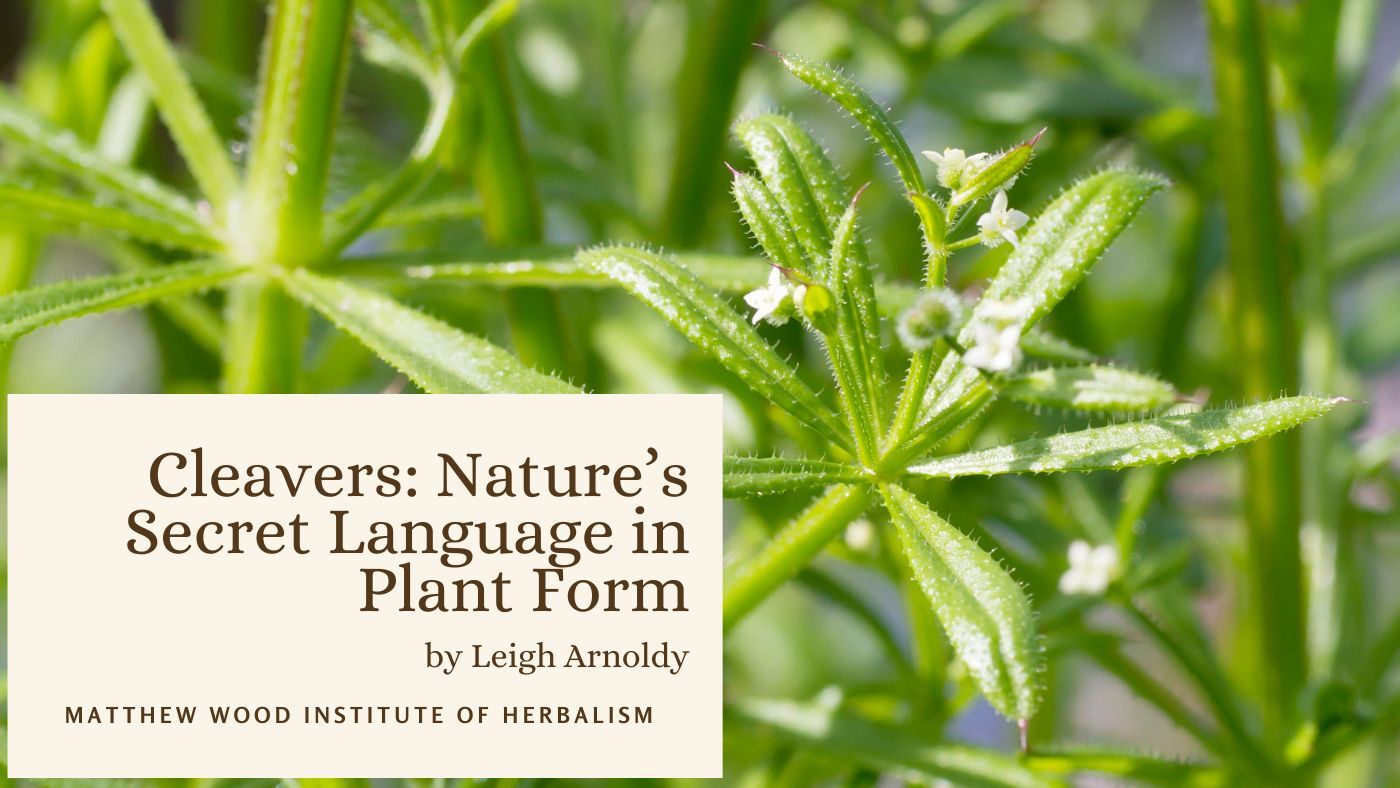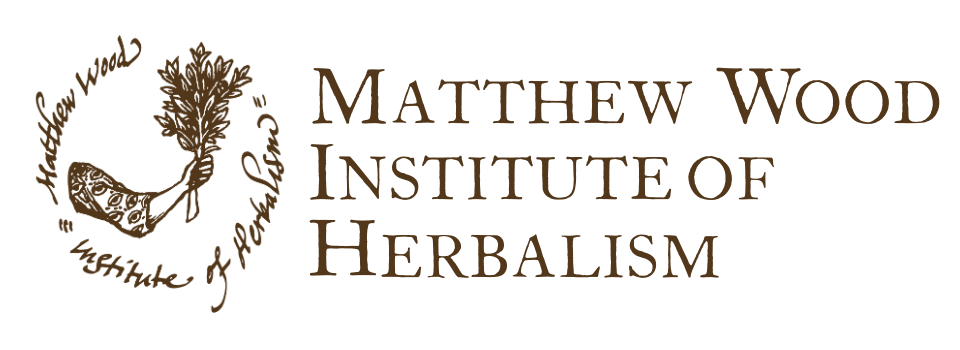Nature speaks to us by encoding in everything she touches: the shape of a leaf, the texture of the fruit, the environment a plant grows in - these are some of the ways Nature communicates the herbal properties of a plant. This was called the Doctrine of Signatures by Jakob Böhme in his book, The Signature of All Things (1621).
Take a close look at Cleavers - what might you notice?
- Small, delicate, white flowers with four petals
- Fruits that are bulbous, hairy, and redden over time
- Fruit structure grouped in twos, side by side
- Leaves that are sticky or that catch
- Leaves that are wrapped around the stem in a star or whorling pattern
- Stem shape that is square
- Stems that creep, crawl, and tangle
- Plant structure that is delicately balanced
- Preferred environment on the edge of two places (transitional)
All of these things by themselves and in combination can contribute to the herbal intelligence of Cleavers.
FRUIT
Compared to the slender dimensions of the stem, the fruits are quite juxtaposed - they stand out as even more bulbous as they would be by themselves. This may bring to mind the bulbous endings of the lymphatic system, which Cleavers has an affinity for. Places where this may be especially helpful are areas of high lymphatic traffic, such as in fibrocystic breasts, glandular issues, and growths (Wood).
The fruits are side by side, giving a testicular look to them. If you combine that hint with a reddish color that may signal heat or irritation and the long, slender stem, you will find yourself with a remedy for swollen prostate, urethra ,or painful testicular issues.
If you are feeling particularly imaginative, you might even see the fruits as eyes - wide away and irritated. Cleavers is a member of the Coffee family (Rubaceae), and can be used in lieu of coffee, giving folks the wide-eyed “buzz” that they may need to help them through the morning.
LEAF
The leaves are in a star or whorl pattern, orbiting the stem, striving to maintain balance, but typically getting caught up in itself. Cleavers can be particularly hard to harvest because it also catches up other things in its environment. I’ve seen this happen with a batch of Cleavers that was growing under an Oak tree: parts of the Oak catkins were stuck within the mat of Cleavers to the point that I had to consider Oak as part of the tincture I made. The leaves tend to cleave to anything they grasp onto. This makes me wonder: can Cleavers be used for dependence? It isn’t an aggressive and domineering climber like the “personality” of Vine Bach Flower Essence - rather, Cleavers seems to gently cling to what it surrounds, and is more aggressive with itself than anything, suggesting that this may be for a person that is mentally berating themselves, or at least they are the source of their own mental exhaustion.
“Cleave” itself is an interesting word: it means both to “cling to” and “to separate.” Cleavers’s medicine works for both: it helps with thoughts that cling to us, whorling around in our brain. Cleavers was also historically used to strain milk; it does the same for our thoughts, straining out the particulates that do not serve us any use. It has been frequently for the nerves.
STEM
The stem is square. Square is not something we see often in the natural world, shaped by the currents and time; it’s in juxtaposition with the whole idea. It creates a bit of tension with its 90 degree angles. This shape is reiterated in the four petals of the flowers. Many plants that have squares, 90 degrees, or crosses have a nerve or tension component to them, such as the entire Mint Family and Vervains.
Cleavers is no exception. As we mentioned, it can be physical tension or mental tension (too much mental activity). Squares are also a way to structure things or mankind’s way of establishing order, reining in the jumble of thoughts in the mind.
Cleavers is no exception. As we mentioned, it can be physical tension or mental tension (too much mental activity). Squares are also a way to structure things or mankind’s way of establishing order, reining in the jumble of thoughts in the mind.
The long, tangling stem with the large fruit also indicates it can be for situations where there is a shortening or tangling of fibers or structures in the body due to nodules: Matthew Wood mentions this is for Dupuytren's contracture, where the hands curl inward due to tissue entanglement and thickening of the nodules.
STRUCTURE
This leads to the Native American designation of Cleavers as a Deer Medicine. Deer Medicine is often delicate, long “limbed,” focused on balance or the head, “antlered,” and favors the edge of the woods. Cleavers doesn’t check as many boxes as some other typical Deer Medicines (i.e. Blue Vervain and Monarda) but it is uniquely a Deer Medicine due to the fact that it is often used as bedding for young fawns.
Deer Medicine is also associated with the nervous system. In the case of Cleavers, it can help with inflamed nerve endings, as well as the nervous mental activity evidenced above. Deer Medicine also has the intelligence of balance: there is usually some aspect of the plant that looks like or behaves like a balancing act, from the teeter-tottering of top-heavy Blue Vervain in the wind or the long, graceful lines of Cleavers, balancing the fruits and leaves like tinker toys.
The word balance also makes you think of the ears (and antlers), which are so important to keeping our heads in an upright position. In traditional Chinese Medicine, the ears are seen as the outward expression of kidneys, which is also tied into Deer Medicine. The kidneys are related to the emotion of fear - we’ve all seen the flash of a deer’s tail as it bolts away from danger, making this an important quality of Deer Medicine. Worry is like a low-grade fear, which we try to conquer by spinning around the “what ifs” in our brains.
Cleavers is also good for the physical kidneys and the related waterways, the bladder and lymphatics. Often fear has an effect on the bladder, making one feel like the need to relive themselves. Matthew Wood states that Cleavers helps with edema, cloudy urine, and the passing of “white sand.”
Also, recall the tiny white flowers. Then compare them to the leaves. The scale is the opposite problem of the other antlered Deer Medicine flowers. What could this mean? I offer a few suggestions:
- Perhaps that this is for the “deer” that doesn’t have the antlers, or for anxiety and women. Or for nervousness related to mothering - the worry that plagues a first time mom may ring true.
- Perhaps the mental energy has been inverted and turned into oneself, giving way to the whorl of the leaves.
- And lastly, maybe this is a signature for focus, the tiny white flower bringing the mental activity to focused point. Or at least making “small” of what once was mentally a big deal. Perhaps Cleavers if for mentally being your own worst enemy.
TESTIMONY
I can verify the power of this gentle plant. I have taken Cleavers for mental thoughts that served no purpose in rehashing - a typical “let go, let God” situation. And it’s as if the thoughts just slipped away.
Want to learn more about cleavers? Get your free, printable set of spring Seasonal Herbalist Cards.
Want to learn more about cleavers? Get your free, printable set of spring Seasonal Herbalist Cards.
Plus you can explore cleavers more fully in our Learn Herbal Wisdom Facebook Group—we’re sharing videos, graphics, plant ID tips, and more every week!
**Disclaimer**
The information provided in this digital content is not medical advice, nor should it be taken or applied as a replacement for medical advice. Matthew Wood, the Matthew Wood Institute of Herbalism, ETS Productions, and their employees, guests, and affiliates assume no liability for the application of the information discussed.
The information provided in this digital content is not medical advice, nor should it be taken or applied as a replacement for medical advice. Matthew Wood, the Matthew Wood Institute of Herbalism, ETS Productions, and their employees, guests, and affiliates assume no liability for the application of the information discussed.


